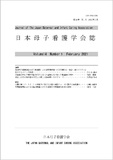Japanese
English
- 有料閲覧
- Abstract 文献概要
- 参考文献 Reference
要旨
目的
分娩進行中に予期せぬ胎児死亡となった産婦を直接受け持った助産師が、どのような体験を経て今日まで仕事を続けてきたのかを明らかにすることを目的とし、助産師への支援プログラムを検討する基礎資料とする。
対象と方法
胎児死亡となった産婦を受け持った助産師4名を対象に半構造化面接を実施した。データ分析は面接内容から逐語録を起こし観察したことを加えて文章化した。各事例のデータを熟読し、助産師の体験・思いに着目して、文脈に留意し、質的帰納的分析を経てカテゴリ化した。本研究は東京医療保健大学倫理委員会の承認を得て実施した。
結果
現在でも影響している体験として、5つのカテゴリが導き出された。〔情報が入らないことで生じる不信感〕等のサブカテゴリから【胎児死亡後の恐怖と不信感】が、〔当時のことを後悔している〕等のサブカテゴリから【持ち続けている心の傷】が、〔同僚の後押し〕等のサブカテゴリから【さまざまな周囲からの支援】が、〔胎児死亡から得た命の重さ〕等のサブカテゴリから【命の誕生の重さと助産師のやりがい】が、〔助産師としての覚悟〕等のサブカテゴリから【助産師としてあり続ける意味】という5つである。
結論
1.【胎児死亡後の恐怖と不信感】【持ち続けている心の傷】【さまざまな周囲からの支援】【命の誕生の重さとすばらしさ】【助産師としてあり続ける意味】の5つのカテゴリが導き出された。
2.助産師への支援の介入は早期に行い、できる限り死産後に母児にも関わることができる環境を整えることが、助産師にとっても母親にとっても悲嘆過程を乗り越えられる早道になることが明らかとなった。
3.胎児死亡体験後も、分娩に対する恐怖心や心の傷を抱えながら、この体験を糧に学びを深め成長していた。
4.支援を得た助産師は、自己のレジリエンスを維持できたため、助産師の仕事を継続することができた。支援が得られなかった場合は、分娩の素晴らしさや働く意味を見出すことができなくなり、働き続けることが難しくなる。
Objective
The purpose of this study was to clarify what had been experienced and/or felt by midwives who had directly took charge of parturient women faced unexpected fetal death during the labor progress and how such midwives had continued with the midwife's tasks after that time and, thus, to serve for basic data for a midwife support program.
Materials and Methods
A Semi-structured interview was conducted with 4 midwives who had took charge of parturient women suffering fetal death. For data analysis, the interview contents were made into a verbatim record and, then, formulated in writing adding what was observed during the interview. Then, the data of each midwife were carefully reviewed and categorized after a qualitative and inductive analysis focusing on what the midwives experienced and felt at and after that happening. This study was conducted after obtaining approval from the Ethics Committee of Tokyo Helthcare University.
Results
The following 5 categories were extracted as midwives' experiences that are still affecting them: ① [Fear and a sense of uncertainty after fetal death] from the sub-category “A sense of uncertainty caused by little information”; ② [Emotional wounds which continue to hold] from the sub-category “Feel regretful for that time”; ③ [Various supports from those around them] from the sub-category “Encouragement from colleagues and others”; ④ [Preciousness and greatness of birth of a new life] from the sub-category “Importance of a life recognized from fetal death”; and ⑤ [Meaning to continue to be a midwife] from the sub-category “Mental preparation as a midwife”.
Conclusions
1. Five categories were extracted such as [Fear and a sense of uncertainty after fetal death], [Emotional wounds which continue to hold], [Various supports from those around them], [Preciousness and greatness of birth of a new life], and [Meaning to continue to be a midwife].
2. It was made clear that earlier intervention for supporting the midwives and improvement of the working environment so that the midwives can be involved in mothers and newborns even after the experience of fetal death will become a quick way to get rid of the distress process.
3. Even after the experience of fetal death, the midwives have grown to develop themselves from their own experience despite a fear of labor and/or mental wounds.
4. The midwives who had got good support were able to continue the midwife's tasks because they could maintain their resilience. In case they get no support, they may have difficulty in continuing working if they fail in finding the greatness of labor and the meaning of working.
Copyright © 2021, The Japan Maternal and Infant Caring Association All rights reserved.


